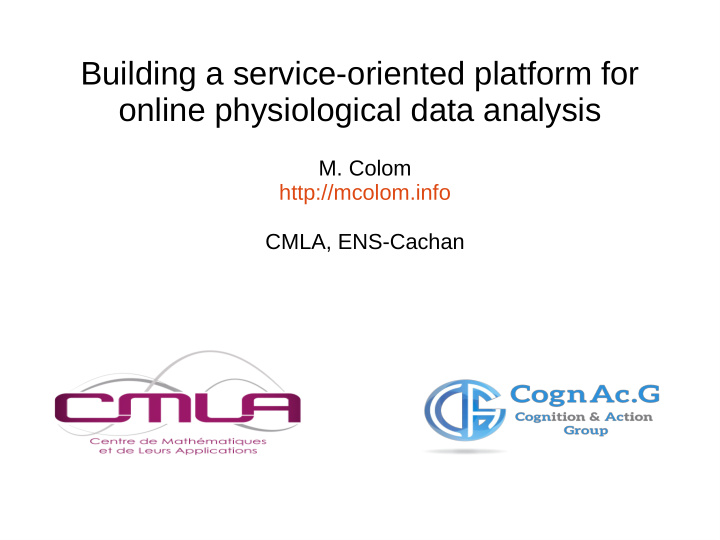



Building a service-oriented platform for online physiological data analysis M. Colom http://mcolom.info CMLA, ENS-Cachan
Reproducible Research ● Redefine the product of research: – Article, source code, data ● Why do we need it? → Trust results ● Applicable to all disciplines? Cosmology, Biology, Computer Science...? ● What if we combine RR with Clinic Research ?
SmartAlgo A new platform for RR in algorithms applied to Clinical Research ● A joint project ● Which kind of medical problems/algorithms? ● Balance and movement – Eye tracking (Infantile Nystagmus Syndrome, Spasmus Nutans-type nystagmus) – ... – → Online prototype demo: Animated Statos
SmartAlgo: Oculo project ●
Similar projects IPOL Run My Code
Some differences... ● IPOL is a full RR journal , with peer-reviewed article and source code. The demos are a valuable tool, but not peer-reviewed. ● The aim of RunMyCode is to give visibility to the results of the research. They publish non-peer-reviewed source code and data. ● SmartAlgo is somewhere in the middle. – Peer-reviewed – A platform for clinical research . Not just a repository of code or demos – Data is real and come from actual physiological signals obtained with sensors – Data needs to be standardized because of the different kinds of sensors (for example: different sampling rates, formats, etc) – Validated and annotated data
A technical challenge? ● Of course. It's a complex system which includes: – Signal preprocessing and standardization – Multiple kind of signals – Annotation of signals – Storing and retrieving efficiently all the information – Complex interface interactions (web, tablets) – Etc. ● So, the main difficulties are technical ? NO
An agreement challenge! ● It's mainly an agreement problem , not just technical – Physicians normally are far away from algorithms, mathematics, formal methods – Mathematicians and engineers are not familiar with neurological pathologies or diagnostic methods – ( Of course! ) – But the problem needs a multidisciplinary approach to apply advanced techniques of signal-processing and machine- learning to obtain results in clinical research . – But physicians and mathematicians/engineers usually talk very different languages...
A dual point of view ● It's the same problems , but seen from different angles ● For example, – Physicians interested in: fall assessment, balance of patients, eye tracking, walk of patients, ... – Mathematicians/engineers interested in: models, classification, regularization, generalization, automatic learning, ... ● Problem : which kind graphical interface should be show? Something in the middle? ● Solution : – Each user has a role (physician, mathematician/engineer) – The graphical interface first matches the general role – But it must be adaptive : it should be customizable and remember the preferences of the user. – Why this way? Two “different worlds”, but the same problem → They should converge .
Only an “agreement problem”? ● Not only! ● Other issues, very particular of this project
Other issues: input data ● Real data from physiological signals – Sometimes incomplete – Might be inaccurate – Characteristics of the sensor might be undocumented – Many different captors and devices – Need to preprocess the input data – Need to standardize all data in a common format
Other issues: privacy ● It's data from real patients ! ● This kind of data can not be – Stored – Made public – ... ● Very strict usage conditions ● Legal framework : l'article 8 de la convention europeenne de sauvegarde des droits de l'homme – la directive 95/46ce – la loi du 6 janvier 1978 – le decret n°2006-6 du 4 janvier 2006 sur l'hebergement de donnees de sante a caractere personnel sur support informatique – l'ordonnance n°2010-177 du 23 fevrier 2010 – article 19 – ... – ● So? Any solution ? – We're within the special case of clinical research : ● Low-level signals ● Need to anonymize data, absolutely
Development cycle ● Designing usable interfaces and proper data visualizators is difficult : – Physicians and mathematicians/engineers have different interests – It's difficult to have an idea of a new system until you see a usable prototype – Even designing and modifying a prototype is expensive in terms of time and human resources
Our proposal: User eXperience Design ( UXD ) ● Interviews with the physicians to understand their needs and the particular problems in their field ● The same with mathematicians/engineers ● Imagine use scenarios ● Design wireframe or mockup interfaces → Show ours ● Discuss these interfaces with the users ● Iterate the prototypes until agreement ● When agreement: write better prototypes (real HTML5/CSS), integrate code , iterate .
At which point are we now? ● Designing use scenarios ● Writing machine-learning and signal- processing algorithms ● Designing adaptive user interfaces ● Building a development team → Need of a large team of engineers, in UX, design, machine learning, integration, coding, … Big project! – Antecedents : we have the experience of have been building IPOL at CMLA . But still very different!
What do we expect of SmartAlgo? ● Reproducible Research ● Provide Clinical Research with a platform with the best machine-learning and signal-processing algorithms . And data! ● Have methods and data we can trust ● Create a large network of clinical and non-medical researcher contributing with data ● Give the technical means ( platform , data , algorithms ) to establish a Clinical Reproducible Research community.
Thank you very much for your attention Miguel Colom Website: http://mcolom.info Email: miguel@mcolom.info CMLA, ENS-Cachan
Recommend
More recommend